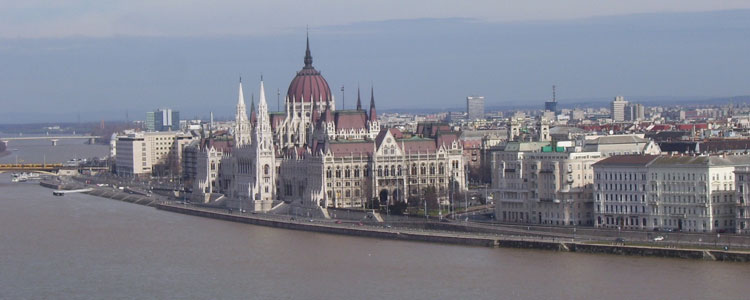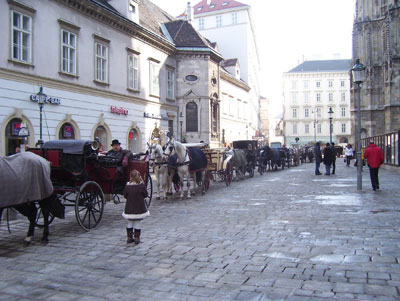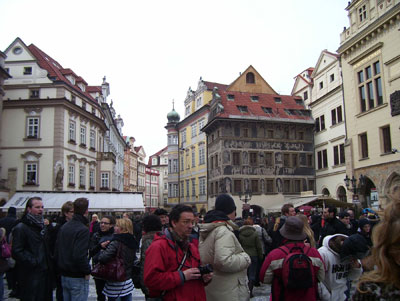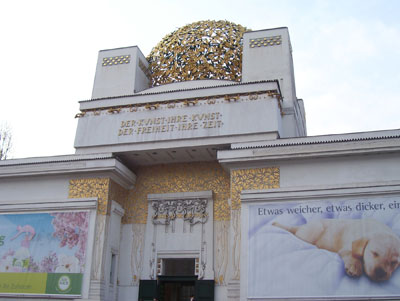A tale of three cities: Recounting a journey to Prague, Vienna and Budapest
by Marvin Herman & Judy Licata; Delavan, Wisconsin
Firm in the belief that during the month of February most people would like to escape the Midwest for a warm climate while waiting for spring to come, my wife, Judy, and I felt that there was no better time to visit some of the wonderful old cities of Central Europe.
To take advantage of lower off-season prices and avoid the crowds, our plan for 2010 was to visit Prague, Vienna and Budapest, spending four nights in a centrally located hotel in each city.
Planning the trip
We booked our flights ($834 each) online through British Airways, leaving from Chicago and, after a brief layover in London, carrying on to Prague. We would return from Budapest.
We arranged with Hotel Metamorphis ($84 per night, including breakfast) to be picked up at the airport in Prague ($41). Accommodations in all three hotels were arranged over the Internet after some research, including checking trip advisor.com to confirm the soundness of our choices. In Vienna our hotel was Pension Suzanne ($142 per night, including breakfast), and in Budapest we stayed at Le Méridien ($120 per night, no breakfast).
Travel between the cities would be by rail. We did not purchase train tickets in advance, believing that we would be able to choose among the many departures, contingent on our sightseeing plans as they evolved. This proved to be a sound decision.
Of the three European Union countries we planned to visit, only Austria is on the euro. The Czech Republic uses the koruna and Hungary, the Hungarian forint. As we always do, we secured local funds from an ATM as soon as we arrived in each country. We took care to leave as much foreign currency as possible in each country as we left its borders.
Prague
At the Metamorphis (phone +420 221 771 011, www.hotelmetamorphis.cz), on quiet Ungelt Square, our room was in a building across the road from the hotel’s reception. Located on the third floor, serviced by a tiny elevator, our hotel room was long and narrow, with massive furniture, a modern bath with bidet, and an armoire set into an alcove.
The neighborhood — about 200 yards from the Old Town Square, the Hussite Týn Church and the famous Astronomical Clock — was one of twisting streets, old historic buildings and streetlamps with glass fixtures.
The hotel provided us with a dinner recommendation, Kolkovna, which is named for the street upon which it is located. Although there was a crowded and smoky bar upstairs, the lower-level restaurant was smoke free and reasonably priced ($65 for two, including beer and service).
After a potato soup served in a bread bowl, Judy had “Moravian Sparrow,” which was not a bird but big chunks of braised pork with dumplings and sauerkraut. I had braised pork shanks with cabbage and potatoes served with a mild mustard and sweet horseradish, washed down with several schooners of the local Pilsner Urquell beer. This was typical of the dinners one can enjoy in Prague.
Each morning, the Old Town Square, crowded with tourists even in February, was set up with kiosks selling sausages, chunks of meat from whole hams roasting on spits over wood fires, delicious crepes rolled in vanilla and cinnamon, etc. The aromas were maddening and redolent of an old-world Christmas market. Live music played in the background as visitors gathered for the hourly chiming of the clock, from which figures emerge as in a huge cuckoo clock.
Crossing the Vltava river on the Charles Bridge, we saw that Prague is all about food, music, architecture and history.
On Saturdays, admission is free to Prague’s St. Vitus Cathedral. A repository of the remains of St. Wenceslas, a symbol of Czech nationalism, the cathedral also contains remarkable stained-glass windows, most notably one by the Art Nouveau painter Alphons Mucha, whose museum we visited the next day.
Exploring the city
Rick Steves recommends that visitors ride the tram to orient themselves within the city, so we bought tickets good for 75 minutes (about $1 each) and did just that. It works best if you can get a seat with a good view out the window.
The next day, on the way to New Town and Wenceslas Square, we walked to the Powder Tower and the adjacent Municipal House, admiring the varied architecture of the area. Prague was not as heavily bombed during WWII as other cities in Europe and thus is the most intact city of those we visited.
The highlight of our time in Prague was our visit to the Mucha Museum, which contains many of the original works of the late-19th-/early-20th-century Czech artist, including his series of Sarah Bernhardt posters. His magnum opus and gift to the Czech people, titled “The Slav Epic,” was on tour in a small town elsewhere in the republic.
After we left the museum, we went to the Hladni train station to buy our tickets to Vienna ($56 for the four-hour-and-40-minute trip). Then we continued on to Wenceslas Square, which is not a “square” at all but a long shopping street where one can buy garnets, popular Czech gems and other souvenirs. At the lower end of the square is Havelská Market, a long series of outdoor stalls selling tourist goods.
It was growing late, so we stopped to have a Kozel, a local dark beer, at U Provaznice (Provaznická 3) and stayed for a dinner of garlic soup, served with fresh rye bread, and goulash with several bread-and-potato dumplings in a thick peppery gravy. Again, the price was reasonable ($50 for two, with beer and service), the service friendly and the back room smoke free.
The next day we headed off to Josefov, the Jewish Quarter. We bought tickets (480 koruny, or $24, per person) to see the entire series of sites comprising the Jewish Museum, which included another highlight of the trip, the Old Jewish Cemetery with its tombstones at crazy angles. It is a monument to the Jewish culture in Prague.
We saw the Pinkas Synagogue, with the handwritten names of nearly 80,000 Czech Jews who were victims of the Holocaust; the exhibit of children’s art from the death camps at Terezin, and the beautiful Spanish Synagogue.
On to Vienna
Our hotel reception called our hotel in Vienna to request directions from Meidling Station, where we would disembark our train. This accomplished, we jumped in the car driven by the hotel porter and were taken to the Hlavni station. We located our train to Vienna, which headed out precisely on time, arriving by midafternoon. At the station we bought tickets to Budapest for four days hence, departing from Westbahnhof, along with four tickets for the metro.
Following the directions we were given, we transferred at the proper metro station and wound up at Stephansplatz, where we surfaced and asked directions to the Opera. Following the pedestrian shopping street of Kärtnerstrasse for several blocks, we then took a short left turn to Pension Suzanne (phone +43 1 513 25 07, www.pension-suzanne.at).
We were disappointed with the size of the room we were shown first. At this hotel we had not paid in advance, having only given our credit card to secure the first night, so we negotiated for a larger room which, when we agreed to pay cash, cost just a bit more than our original room.
My first impression of Vienna (I hadn’t been there for 30 years) was that it was a much more sophisticated city than the rather provincial Prague. It is a city of wine, not beer.
Exploring the city
We headed to dinner at Stadtheuriger Gigerl (Rauhensteingasse 3), a restaurant serving the “new wine” of Grinzing. It is a Rick Steves recommendation and he rarely steers us wrong. We ordered an appetizer and entrée for two, and for €46 ($59) we busted our bellies on pork, ham, schnitzel, potatoes, dumplings, chicken, cheeses and more.
Rick also was dependable the next morning when we took a walking tour of the city following his directions. We wound up at the Hofburg Palace and bought a combination ticket (€9.90, or $12.80, per person) to see the Imperial Porcelain & Silver Collection, the Sisi Museum and the Imperial Apartments. The best of these was the Sisi Museum, which presented the saga of the Empress Elisabeth, wife of Emperor Franz Josef, before and during her husband’s reign and until her assassination.
Tired from touring, we sought refuge at Café Tirolerhof (Führichgasse 8), where we each partook of the decadent Viennese tradition of coffee and a large, doughy pastry with a great quantity of hot vanilla sauce ($20 for two, including service).
Thus fortified, we walked across the Ring Road to the Naschmarkt and strolled amongst the food stalls, stopping to buy cheese, olives and fruit to eat in our room.
After breakfast the next morning we decided to take a tram ride, being careful to validate our tickets. Fortunately, we were “legal,” because two fellows in blue jackets came aboard to check everyone’s tickets. (There is a large penalty for being on a tram without a validated ticket.)
We took the tram to the Prater amusement park to ride the big Ferris wheel. It wasn’t worth the money (€8.50, or $11, each), but the view was nice and the line was short.
After a stop at the Natural History Museum to buy a replica of the “Venus of Willendorf” statue, an exaggerated figure of a woman that was found in a prehistoric dig in Austria, we got ready for a tour of the Vienna Opera.
There were almost 200 people on the tour, the group divided up by language. We attend many operas in Chicago, but the Vienna facility is more utilized, better financed and a real historical gem.
An afternoon amble
The next morning, while Judy went shopping, I walked to the tourist information office to find out how to get to the Wienerwald (Vienna Woods). Our plan was to take a tram to the top of Kahlenberg and walk down through the woods to Nussdorf, where we would have a meal at a Heuriger, or wine tavern, before returning to Vienna by tram.
We set out, the day foggy and drizzly. The walk we planned usually takes about an hour, but it took a bit longer since we used the narrow road rather than the path, which was snow covered and unsafe without proper boots.
The vineyards looked desiccated as they awaited the spring.
Occasionally a cyclist would pass and we would ask directions to confirm we were getting closer to Nussdorf.
Since the Heuriger we wanted to visit was not open until later in the afternoon, we ducked into a warm, cozy café for some Viennese coffee served with whipped milk. We then walked to the Heuriger, Schübel-Auer (Kahlenbergerstrasse 22).
Upon entering, we inhaled the wonderful aromas of ham, roast pork, schnitzels, sausages, potatoes and dumplings, all on display in glass cases. After considerable study, we pointed to what we wanted to try. We then sat at a table, where our wine order was taken.
The experience, which cost €43 ($56), was a definite highlight of our time in Vienna. The walk down from Kahlenberg to Nussdorf was priceless.
Budapest bound
The next day we took our bags on the metro to Westbahnhof and took an elevator to the ÖBB Railjet station for our trip to Budapest’s Keleti Station, which looks like something out of an old movie that was set in 1900. At Keleti we were approached by many taxi drivers who prey upon tourists getting off the train. The best advice is to ignore their persistent requests that you use their services.
We saw an information center in the corner of the station and walked inside. We were alone except for two mirthless ladies dressed in 1950s-style clothes. They spoke little English.
I asked two questions: “Where is an ATM?” and “Where is the metro station?”
One woman answered with a vague gesture to the outside of the station.
Crossing the street to a temporary wooden sidewalk, I came to a bank and got some forints. A passerby directed us to the nearby metro station and off we went. We bought two tickets to the Deák ter metro stop, above which our hotel was located.
Checking in at Le Méridien Budapest (phone 36 1 429 5500, www.le
meridienbudapest.com) — after an attempt to upgrade us to a “deluxe” from our booked “superior” room and a try at selling us breakfast at €25 each per day — we were taken to our large, modern, well-appointed room with a crystal chandelier, writing desk and sofa, not to mention a big, flat-panel TV.
Here, we were charged for a telephone call made with a prepaid phone card after we were told there would be no charge and for a small contribution to UNICEF, the pet charity of the hotel, without being asked in advance if we would approve the charge. I expected more from a hotel of this genre.
That night at Café Kör, a restaurant near the hotel, we imbibed Hungarian wine to complement our sour cream soup with sorrel followed by beef goulash and chicken paprikash. Dessert was chestnuts and sour cherries with whipped cream. The entire meal cost about $60.
A few highlights
Hungary still suffers from the social and economic influence of the Soviets. The older people, having endured life not only under the Communists but the Nazis as well, understandably seemed rather dour. It seemed the younger Hungarians had more hope. Of the cities we visited, we found quite a bit more construction and rehabilitation of old buildings in Budapest.
After breakfast in our room (food we had brought in the previous night from a convenience store in the neighborhood), we walked to the Danube, crossed the Chain Bridge to the Buda side and took the funicular to the Royal Palace and the various sights in the area.
Walking down from Castle Hill, we stopped at our hotel to get our swimsuits, then hopped on the metro to Széchenyi Thermal Baths, one of the highlights of our stay in Budapest. It was quite crowded for a Sunday in very early March.
Many of the bathers were tourists, but we saw no Americans in the two hours we spent there relaxing and people-watching. We left the baths quite invigorated.
On our way back to the hotel, we stopped at the beautiful Opera House to secure tickets to an opera.
With our trip winding down, we were ready for yet another highlight, this done on the spur of the moment. Judy had read about Budapest’s Bábszinház, or puppet theater, and as we left the hotel in the morning she asked the concierge if there was a show that day. Indeed there was, and we had 45 minutes to get there. Off we went, making it with time to spare.
However, we were told that no seats were available, as school groups had booked the entire theater, but when we spoke to a lady who appeared to be in charge, she told us to wait and there would be room for us in the back.
With first-class music and costumes, this was a very well executed and professional show done with life-size puppets operated by a crew of 10. Though performed in Hungarian, the story was easy to follow. We would recommend this to any visitor to Budapest. Tickets cost about $10 per person.
One final night
On our last night in Europe we attended the opera. It was “Eugene Onegin” by Pyotr Tchaikovsky, performed in Russian with Hungarian subtitles. The more-than-100-year-old, state-supported facility was small but elegant, with boxes along the sides and a gallery about four levels up, under a ceiling painted in the style of the Sistine Chapel. This gallery was where we sat.
We had only a partial view of the stage for the first act, but after that we moved down to the first row, where we could see the entire stage.
Based on our experience at the opera back home, this was a first-class production — another highlight of our trip. Did I mention that our tickets cost HUF300, about $1.50, each?!
When planning this trip, we had questioned ourselves as to whether there was enough diversity amongst the cities we would visit to make each visit worthwhile. The answer is a definite “Yes!”
The time of year made the experience much more affordable and much less crowded than had we done it at a peak travel time. This is one of the best European trips we have ever taken and we would encourage ITN readers to visit these great cities soon.






